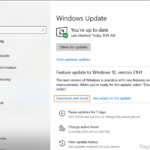Microsoft released on May 18, 2021 the latest major update for Windows 10 (aka: “Featured Update to Windows 10, version 21H1”), mainly with security enhancements in remote work and in document opening, while Windows Defender Application Guard protects you from potential security threats.
By the time this article is written, Microsoft has only announced the following issues with the Windows 21H1 Update:
- A high-pitched noise might be heard when using 5.1 audio with certain settings
Certain combinations of apps, audio devices and Windows settings might produce a high-pitched noise when using 5.1 audio
OS Build 19043.906. - Automatic input of Furigana might not work as expected
In certain circumstances, the automatic Furigana input/conversion feature may not work as expected in apps.
* Note: This bug is first discovered after installing after installing the KB5000842 update. To mitigate this issue, you can try one or more of the following:
- Streaming the video or audio in a web browser or different app, instead of the app affected by this issue.
- Enable Spatial sound settings by right clicking or long pressing on the volume icon in the notification area, selecting Spatial sound (Off) and selecting any of the available options.
How to Get the Windows 10 May 2021 Update (21H1).
In order to update your system to Windows 10, version 21H1, you must be running Windows 10, version 2004 or 20H2. To find out the installed Windows 10 version, go to Start -> Settings –> System –> About.

To install the Feature Update to Windows 10, version 21H1, go to Start -> Settings -> Update & Security and click Check for updates. If the update is available for you device, it will appear after the update checking.
If you want to install the Windows 10 21H1 update without problems, do not press the Download and install link now and follow the instructions below to avoid or to resolve installation problems.
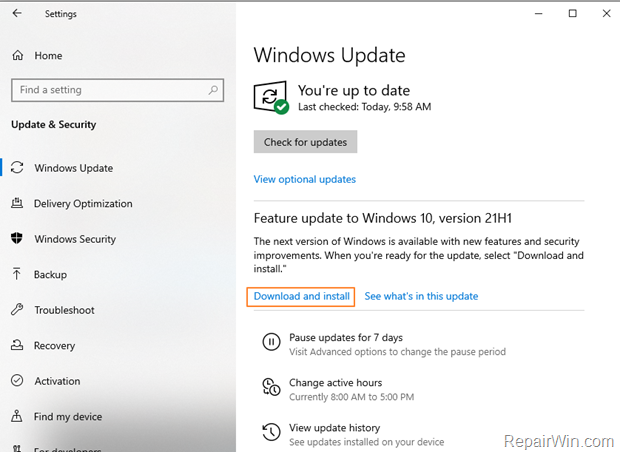
How to Avoid Windows 10 21H1 Update Installation problems.
Before installing Windows 10 21H1 update, perform the following actions:
- Step 1. Ensure that you have enough free space on your disk. Windows 10 requires at least 32 GB of free space to upgrade.
- Step 2. Run Disk Cleanup and delete all the useless files.
- Step 3. Download and install latest Servicing Stack update according your Windows 10 version.
- Step 4. Disconnect all external USB drives & SD cards and any other USB device that don’t needed to install Windows.
- Step 5. Temporarily uninstall any non-Microsoft Antivirus/Security software.
- Step 6. Disable BitLocker drive encryption (if it’s enabled).
- Step 7. Create a System Restore point of the current Windows state, to restore your system to it if the update fails.
- Step 8. Disable Startup Programs. To do that, press the CTRL + SHIFT + ESC keys to open the Task Manager. In Task Manager, select the Startup tab and disable all programs that run when Windows starts.

After performing the above actions, navigate to Start -> Settings -> Update & Security and click the Download and install to install the Feature Update to Windows 10, version 21H1. Now wait (about 20-30min), until Windows prompts you to Restart now your system to finish installing the update.

After a few restarts and if everything goes smoothly, the 21H1 update will be installed on your system without problems. If this does not happen and the Windows 10 Update 21H1 fails with an error (e.g. “Feature update to Windows 10, version 21H1 Failed to install – Error Code: 0x800f0984”), continue reading below to solve the problem.
How to FIX Windows 10 21H1 Update Installation problems.
If Windows 10 21H1 Update failed to install, follow the below methods to solve the problem.
Method 1. Update to Windows 10 21H1 by using the Update Assistant.
1. Navigate to Windows 10 download site and click the Update now button.

2. Save the “Windows10Upgrade9252.exe” file on your desktop.
3. Double click at the downloaded file to open the Windows Upgrade Assistant.
4. Click Update Now to start the update.

5. Let Windows to finish the downloading and the verification phase.
6. When the verification is reaches 100%, disconnect your computer from the Internet, (or set it to “Airplane mode” if you own a laptop).
7. Then, wait until the Windows 10 21H1 update is installed on your system.
8. Finally, when prompted, restart your system to install the update.
Method 2. Update to Windows 10 21H1 from ISO or USB.
The next method to bypass problems while installing 21H1 update in Windows 10, is to update Windows from an ISO file. To do that:
Step 1. Download Windows 10 in a ISO File.
1. Navigate to Windows 10 download page and click Download tool now to download the Media Creation Tool.
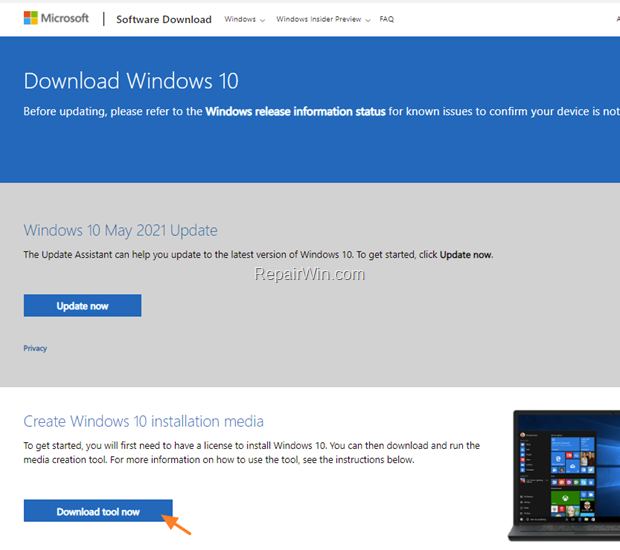
2. Run the ‘Media Creation Tool’ and Accept the License Terms at the first screen.
3. Select Create installation media for another PC.

4. At ‘Language, architecture and edition’ screen click Next.
5. Select ISO file and click Next.
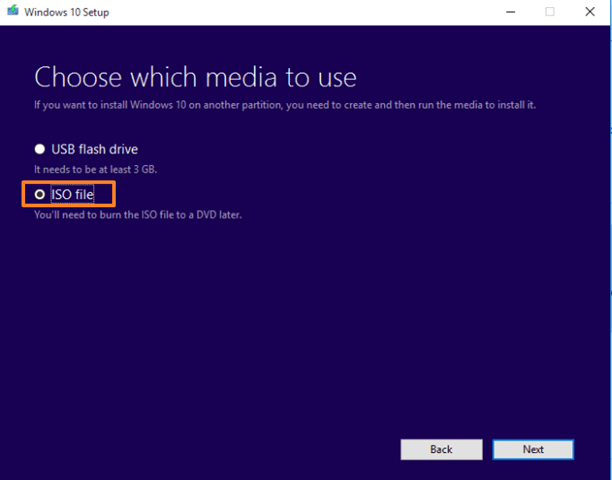
6. Save the ‘Windows.iso’ file to your desktop.
7. The Media Creation Tool will now begin to download the Windows 10 in an ISO format.
8. When the download is completed, close the Media Creation Tool.
Step 2. Update Windows 10 from the ISO file.
1. Double-click at the Windows.ISO file on your desktop.
2. Open File Explorer and explore the contents of the new drive letter created after opening the ISO file.
3. Double click at setup.exe and then click Next to install Windows 10.

4. Accept the License Terms and then click Install.
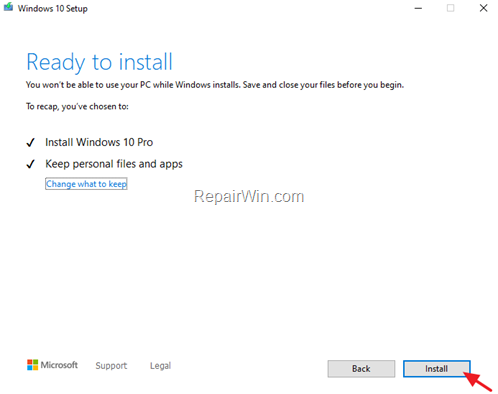
5. Now wait the update process to complete. *
* Note: If the update fails again, burn the Windows ISO file to a USB drive and then try to repair and upgrade Windows 10 from USB.
Method 3. Repair Windows Component Store & System Files.
1. Open Command Prompt as Administrator.
2. In command prompt give the following command and press Enter:
- DISM /Online /Cleanup-Image /StartComponentCleanup
![image_thumb[6] image_thumb[6]](https://qnet88.com/wp-content/uploads/2021/12/image_thumb6_thumb-7.png)
3. When the process is completed, give the following command:
- DISM.exe /Online /Cleanup-image /Restorehealth

4. When the DISM operation is completed, type the following command and hit Enter:
- sfc /scannow

5. Now wait until the System File Checker repairs the Windows System Files.
6. When this done, restart your computer.
7. After restart, open Disk Cleanup and open Clean up System Files. Select to delete the following files and click OK:
- Temporary Windows installation files
- Windows Update Cleanup
- Windows upgrade log files.
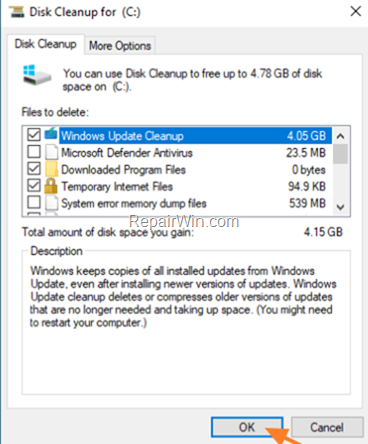
8. When done, use the instructions on method-1 above to update Windows using the Windows 10 21H1 Update Assistant
Method 4. Clean install Windows 10.
The last method, to fix the Windows 10 21H1 update problems, is to perform a clean installation of Windows 10 on your system. * To do that, read the instructions on this article: How to clean install Windows 10.
* Important: The clean installation of Windows 10 , means that all your files and settings will be lost during the installation process. So, proceed and backup all your important files and settings to another storage media (e.g. to an external USB drive) before continue to clean install Windows 10.
That’s all folks! Please leave a comment in the comment section below or even better: like and share this blog post in the social networks to help spread the word about this solution.

